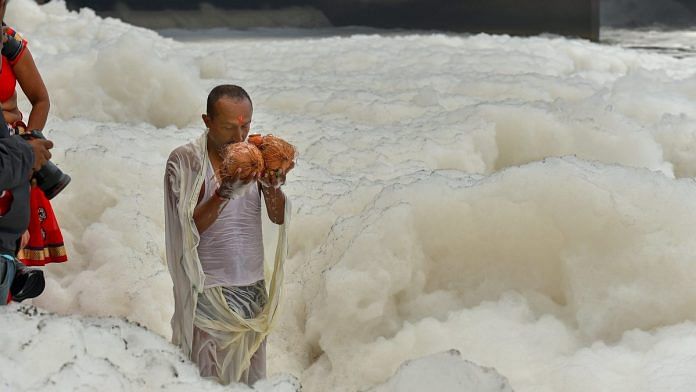New Delhi: A layer of toxic foam has been floating on the surface of the Yamuna near Kalindi Kunj in Delhi for the last few days. Following this, the Delhi government Tuesday banned fishing in parts of the Yamuna citing high pollution levels in the river.
However, the formation of toxic foam in the Yamuna is not new. Every year, during the Chhath Puja, images of devotees standing in waist-deep toxic forth in Yamuna make headlines.
Even Sanskrit poet Avaghosa in his poetry, dating as far back as the 1st century, mentioned the presence of foam in Yamuna’s waters.
ThePrint explains the science behind this froth.
Phosphates in water
Under natural circumstances, the formation of lines of foam on the surface of water is very common.
Dead and decaying parts of plants contain fats molecules that do not mix with water. They form an invisible floating layer on the water surface. When the water gets disturbed by waves, natural waterfalls, or artificial falls from river barrages, this fatty layer gets beaten into a froth — similar to how shaking up soapy water causes air to get trapped in tiny bubbles that form a layer of foam.
The foam made from organic matter in rivers and lakes can last for a long time.
However, the amount of foam visible in present-day Yamuna cannot be explained by such natural phenomenon.
According to Sushmita Sengupta, a scientist working with the Water Programme at Centre for Science and Environment, the high level of phosphates in the Yamuna is what causes such foam to build up.
Phosphates are an ingredient used in many detergents which are designed to reduce the surface tension of water. These compounds make cleaning a lot easier.
However, these phosphates persist in water, which leads to eutrophication — a process by which a water body becomes enriched with minerals and nutrients, causing the growth of algae that in turn cuts off oxygen from mixing with the water and sunlight from reaching the depths of the water body.
This lowers the oxygen content, killing off marine life that is essential to maintain the quality of water.
These phosphates are responsible for the alarming amount of foam that forms on the surface of the river, similar to the foam created by detergents.
“Raw, untreated sewage is constantly dumped into the Yamuna in Delhi. The sewage contains detergents from households as well as industries,” Sengupta said.
According to Sengupta, several detergents that make their way into the river are not approved by the Bureau of Indian Standards, which regulates the content of phosphates in detergents.
Also read: Why Delhi Jal Board is just not able to clean up the Yamuna mess
Concentration of phosphates in Yamuna
According to a Delhi Pollution Control Committee report, the concentration of phosphates in the Yamuna varies from 6.9 mg/l at Okhla to 13.42 mg/l at Khajoori Paltan (downstream of Najafgarh drain).
In 2020, the Bureau of Indian Standards prescribed Sodium Tripolyphosphates percentage for the household laundry detergents should be 5 for detergent bars, 2.5 for powder, and zero for household detergents for woolen and silk fabrics.
Anshuman, Senior Fellow and Associate Director of Water Resources Policy & Management Area at TERI, explains that along with the presence of phosphates, the water also needs to be agitated to form the foam.
This can be achieved if strong winds blow over the surface of the water, or heavy rain pours on the surface, he told ThePrint.
The Okhla Barrage, from where the water is released also plays a part in churning up the waters — leaving a foamy cover downstream of the barrage.
In a healthy flowing river, Anshuman said, the phosphates can get diluted over time, which would eventually cause the froth to disappear.
However, if the amount of such compounds is too high in the water, the river cannot clean itself, he added.
Anshuman also explained that phosphates is a skin irritant, and the presence of sewage and other pollutants in the river can make the foam toxic.
Also read: Yamuna oxygen levels below detection limit in 5 states, UP has most polluting drains — govt



